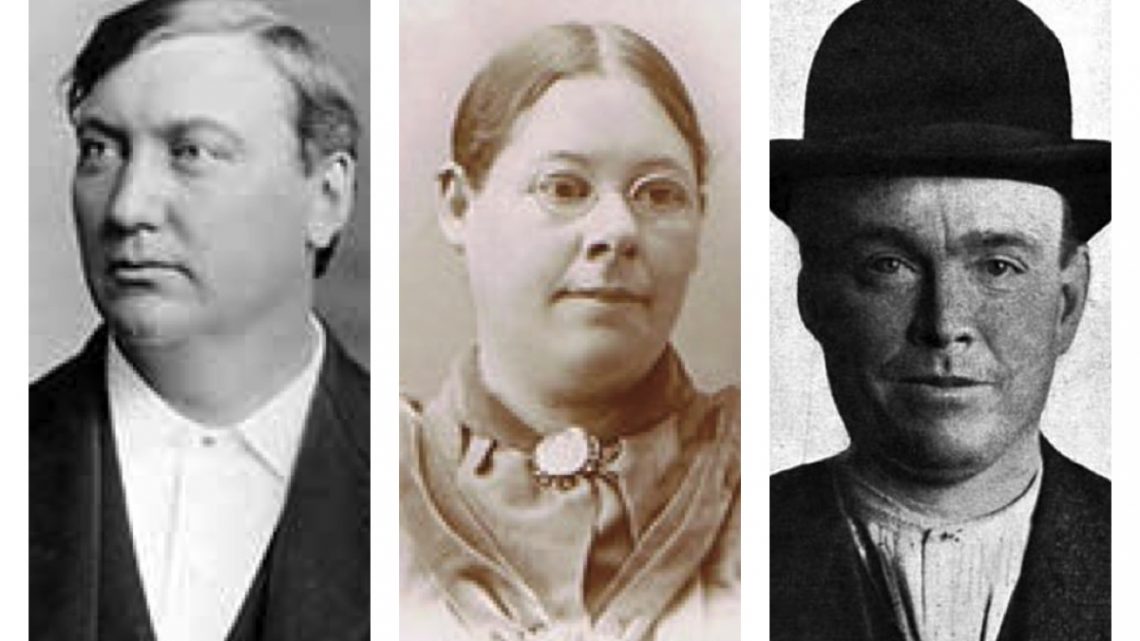At the time, the assassination of former Idaho Governor Frank Steunenberg in retaliation for his anti-labor union policies, which angered leaders of the Western Federation of Miners, was a national sensation. Headlining newspapers from San Francisco to New York City, one would have been hard pressed to find anyone who did not know about the governor’s death on December 30, 1905, when a bomb planted at a gate to his home in Caldwell, Idaho, by hired assassin, Albert Edward Horsley–a.k.a. Tom Hogan a.k.a Harry Orchard–exploded. Newspapers recounted in gruesome detail the 20 or 25 minutes between the explosion and Steunenberg’s last heartbeat. Besides the extensive damage to the governor’s body, the blast–some said felt for 50 feet, others said it was felt all over town–blew the glass out of all the home’s windows. Mrs. Steunenberg was understandably traumatized and reported to be under the care of a physician.
The assassin, Horsely, better known as Orchard, was born March 18, 1866, in Wooler, Ontario, Canada. A ne’er do well and spendthrift, over the course of his life, Orchard abandoned two wives and committed a multitude of crimes from theft and kidnapping, to insurance fraud, arson, and finally murder.
What fewer people knew, was that the governor’s wife was a Seventh-day Adventist. Born June 18, 1863, in Keokuk, Iowa, Eveline Belle Keppel (often shortened to Belle) was the daughter of a Dutch immigrant–actually both Frank and Belle Steunenberg were of Dutch ancestry and cousins, as his mother and her father were siblings, both of whom were born in the Netherlands. In 1905, the Caldwell Tribune described Belle as “an active and zealous worker in the cause of temperance.”
The Steunenbergs married on June 25, 1885, in Knoxville, Iowa, and in 1886 they moved to Idaho. Frank Steunenberg joined his brother as a partner at the Caldwell Tribune and soon became involved in politics. He was a delegate to Idaho’s constitutional convention in 1889 and the fourth governor of Idaho, serving from 1897-1900. A tall and imposing man, he was tough on corrupt and violent labor unions, he reportedly supported women’s suffrage, and advocated tolerance toward Mormons. What he thought of his family joining the Seventh-day Adventist Church around 1904 is unknown.
Belle Steunenberg was left a widow at 42-years of age with four children ranging from ages 19 to 3 years old. While her husband’s death was a staggering loss, she recovered to raise her children to honor God, and her own leadership in the Adventist Church in Idaho set an example of Christian service before them. Her obituary later claimed, “it was impossible for her to hold a grudge.” She was member of the committee which helped organize the Church’s work in southern Idaho in 1906. In 1915, she sold the family’s Caldwell home and moved to College Place, Washington, where her children could attend Walla Walla College.
Meanwhile, Governor Steunenberg’s assassins went on trial in an Idaho court drama that pitted two famous lawyers against each other, William Borah and Clarence Darrow. The trial itself was significant for labor unions for, although Orchard turned state’s evidence, acknowledged that he was a hired gun for the Western Federation of Miners, and implicated union leaders William Dudley Haywood, Charles Moyer, and George Pettibone, the union men were acquitted. In the end only Orchard went to prison.
Although her husband’s death devastated Belle Steunenberg, after the trials concluded, she began to write Orchard, send him Adventist literature, and eventually visited him in prison on more than one occasion. Her forgiveness of Orchard, led to his conversion. Orchard remained in the Idaho State Penitentiary for the rest of his life where he became active in prison ministry and published his story in the book, Harry Orchard, the Man God Made Again (1952). His ministry led to the conversion of other prisoners, and the change in his demeanor was so drastic that the judge who sent him to prison claimed he hardly looked like the same man.
The Steunenberg children continued their mother’s legacy of forgiveness and faithfulness to the Adventist message. Julian Pope Steunenberg (July 1, 1886-February 11, 1966) completed college, but worked as a laborer in a wide range of businesses and industries. He remained a member of the Adventist Church until the end of his life. Frances Lucy Steunenberg (August 12, 1892-August 17, 1956) married Fred Eastman on April 20, 1930. She became a nurse, training at Loma Linda School of Nursing where she graduated in 1922. She worked at Loma Linda and Glendale Sanitariums, and White Memorial Hospital. Frank Willis Steunenberg (March 1, 1900-August 12, 1990) became an Adventist minister and teacher, working in the North Pacific and Pacific Unions. He graduated from Walla Walla College and taught at Laurelwood Academy, Auburn Academy, and Gem State Academy. An adopted daughter, Edna Jessie Steunenberg (September 25, 1902-January 1, 1981), attended church school in College Place, Washington, before moving to California where she married Herbert L. Oldridge and became a homemaker.
In 1952, the same year Orchard’s book was published, Frank Willis Steunenberg published his own story of his family’s involvement with Orchard in a book entitled Greater Love. As an older man, however, Frank Willis was disturbed that Orchard had become the hero of this story, overshadowing his own father’s contributions to Idaho history, and his legacy of bravery and courage in the face of a violent labor dispute. In 1974, he self-published his father’s story in The Martyr of Idaho.
In 1921, Belle Steunenberg moved to California to be near her adult children. She died in Angwin, California, on January 7, 1951. Her body was returned to Caldwell, Idaho for burial.
Harry Orchard died in the Idaho State Penitentiary on April 13, 1954, and after a funeral in the Boise Seventh-day Adventist church, he was buried in Morris Hill Cemetery. His life a testament to the power of forgiveness.










